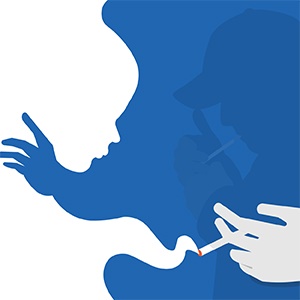

Smoking is a health hazard to you and those around you.
What is passive smoking?
Passive smoking occurs when anyone (including the smoker) inhales tobacco smoke from the environment. This environmental or “secondhand” smoke comprises two parts: smoke exhaled by a smoker (mainstream smoke) and smoke produced from the tip of a burning cigarette (side-stream smoke). Smokers only inhale about 15 percent of the smoke from a cigarette. The rest enters the atmosphere.
How dangerous is passive smoking?
Secondhand smoke contains all the same carcinogenic and toxic chemicals that the smoker inhales, but at even greater levels. The toxins in secondhand smoke aren't filtered as they are when inhaled directly from the cigarette. And, because side-stream smoke is formed at lower temperatures, it gives off even larger amounts of some harmful substances. It's estimated that if a non-smoker sits in a smoke-filled room for eight hours, he will inhale the equivalent amount of carcinogens to smoking 36 cigarettes!
Secondhand smoke can cause:
- Sneezing.
- Coughing.
- Sore throat.
- Headaches.
- Nausea.
- Dizziness.
- Eye irritation.
- Increased heart rate and blood pressure.
Passive smokers are also at an increased risk for nearly all the medical conditions associated with smoking. These include:
- Lung cancer. Secondhand smoke can cause lung cancer in non-smoking spouses of heavy smokers, and in non-smokers exposed to smoke in the workplace. Non-smokers exposed to secondhand smoke have an 18 to 32 percent higher risk of developing lung cancer than those not exposed. The longer the exposure period, the greater the risk.
- Asthma. Secondhand smoke can cause and worsen asthma symptoms like wheezing, coughing, and shortness of breath. Secondhand smoke has also been linked to other respiratory problems, including pneumonia, sinus infection, and impaired lung function. Children whose parents smoke are more likely to suffer from colds, pneumonia, bronchitis, ear infections, and allergies.
- Heart disease. Just 30 minutes of exposure to secondhand smoke can damage a non-smoker's heart, and increase the risk of heart disease by 30 percent. Toxins exhaled by smokers can decrease oxygen to the heart, increase blood pressure and heart rate, lead to blood clotting, and damage the lining of the blood vessels.
- Reproductive problems. Being exposed to secondhand smoke can significantly reduce a woman's chances of conceiving. Conception is even more difficult for a woman who smokes and is exposed to passive smoke. Middle-aged men who are heavily exposed to secondhand smoke have nearly twice the risk of impotence.
Smoking and being exposed to secondhand smoke during pregnancy can also increase the risk for miscarriage, low birth weight, stillbirths, and sudden infant death syndrome.





 Publications
Publications
 Partners
Partners















